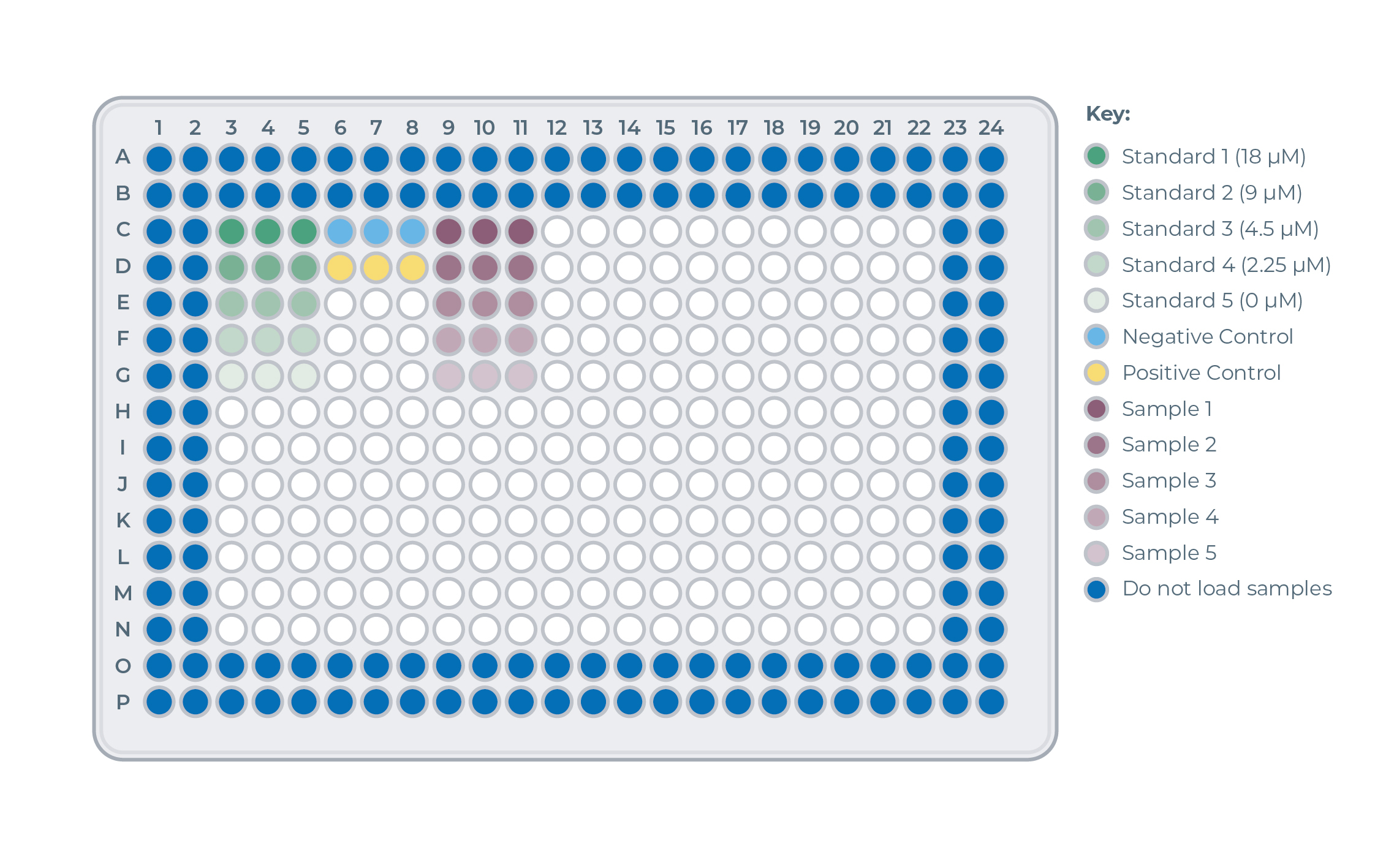eProtein Quantification Kit Protocol
General Information
The Quantification Kit (NC3014) allows the user to accurately quantify protein yields immediately after scale up using the same fluorescence-based method used on-cartridge. Same system, same workflow, consistent results.

Compatible with standard plate readers, the detection tag on your scaled-up protein binds to a complementary detector protein, generating a fluorescent signal calibrated to a universal control.
Features and benefits
Scalable: Consistent workflow, from screen to scale. Plate reader compatible
Accurate: Sensitive fluorescence-based detection ensures accuracy
Streamilined: Eliminates extra prep or method transfers. Scale up ready
Contents
| Component | Volume | Cap Color | Storage Temperature | Tube Reference number |
|---|---|---|---|---|
| Detector Protein | 75 µL | Yellow | -80°C | NQK-01 |
| Universal Control | 20 µL | Yellow | -80°C | NQK-02 |
| Complementation Control | 20 µL | Yellow | -80°C | NQK-03 |
| Wash Buffer | 800 µL | White | -80°C | NQK-04 |
User supplied equipment
▷ Microplate reader capable of measuring fluorescence at Ex/Em = 485/520.
▷ Fluorescence assay-compatible microplate (e.g. Corning, 3544) with the following specifications:
- 384-well
- Low volume (50 µL)
- Black walls with clear bottom
- Flat bottom
- Polystyrene with a nonbinding surface
▷ Adhesive PCR plate seal.
Storage and Stability
▷ The kit must be stored at −80°C.
▷ Avoid freeze-thaw cycles.
▷ Thaw reagents on ice, briefly centrifuge, and pipette mix prior to use.
▷ Reactions should be assembled on ice.
Reaction Assembly Overview
| Standards | Negative Control | Positive Control | Protein Samples | |
|---|---|---|---|---|
| Wash Buffer | 8 µL | 9 µL | 8 µL | 5 µL |
| Diluted Universal Control | 4 µL | X | X | X |
| Complementation Control | X | X | 1 µL | X |
| Protein Sample | X | X | X | 4 µL |
| Detector Protein | X | 3 µL | 3 µL | 3 µL |
| Total per Well | 12 µL | 12 µL | 12 µL | 12 µL |
Standard Curve Preparation
- Prepare the following serial dilution of the Universal Control.
- Prepare a fresh set of standards for each quantification.
- When performing serial dilution of the Universal Controls, pipette up and down 5 times to mix the reagents.
- Use a fresh pipette tip for each dilution step.
- Each dilution provides enough standard to set up triplicate readings.
| Standard Concentration | Volume of Universal Control | Volume of Wash Buffer | Dilution Number |
|---|---|---|---|
| 18 µM | 15 µL of undiluted | 15 µL | 1 |
| 9 µM | 15 µL of 18 µM dilution | 15 µL | 2 |
| 4.5 µM | 15 µL of 9 µM dilution | 15 µL | 3 |
| 2.25 µM | 15 µL of 4.5 µM dilution | 15 µL | 4 |
| 0 µM | 0 µL | 15 µL | 5 |
- Add 8 µL of Wash Buffer to five wells of the 384 well assay plate in triplicate.
- Add 4 µL of the above serial diluted standard in triplicate to the wells containing Wash Buffer (total well volume of 12 µL).
Preparation of Negative Control Reactions
- Add 9 µL of Wash Buffer in triplicate to the assay plate.
- Add 3 µL of Detector Protein to the three wells containing Wash Buffer (total well volume of 12 µL).
Preparation of Positive Control Reactions
- Add 8 µL of Wash Buffer in triplicate to the assay plate.
- Add 1 µL of Complementation Control to the wells containing Wash Buffer.
- Add 3 µL of Detector Protein to the three wells containing Wash Buffer and Complementation Control (total well volume of 12 µL).
Preparation of Test Samples
- For each sample to be quantified, add 5 µL of Wash Buffer in triplicate to the assay plate.
- Add 4 µL of sample protein to the wells containing Wash Buffer.
- Proteins with a predicted yield of more than 18 µM on the eProtein Discovery™ should be diluted 1 in 2 in Wash Buffer before quantification.
- Add 3 µL of Detector Protein to each well containing Wash Buffer and sample protein (total well volume of 12 µL).
Assay Plate Layout Overview

Incubation
- Seal the assay plate with an adhesive PCR plate seal. Ensure the plate is fully sealed before proceeding.
- Briefly vortex the plate and pulse centrifuge for 15 secs.
- Incubate the assay plate for 5 hours at 29°C.
- For overnight quantification, the assay plate can be incubated at 29°C directly in the plate reader with the program set to measure fluorescence after 5 hours. Ensure that the plate seal is left on and the program is set to bottom reading mode.
Measurement
- After 5 hours measure the fluorescence of all standards, controls, and samples in a plate reader with a 485 nm excitation filter and a 520 nm emission filter.
Data Analysis
- Calculate the average fluorescence reading for each standard.
- Subtract the 0 µM reading from all other standard readings.
- Plot the µM concentration of each standard against the measured fluorescence intensity, fit a linear trendline, and set the intercept to 0.
- Calculate the average fluorescence intensity for each set of controls and protein samples.
- Subtract the average fluorescence reading for the negative control from the positive control and protein sample measurements. The expected concentration of the positive pontrol is approximately 9.0 µM.
- Use the linear trendline equation to calculate the molarity of the protein samples and positive control.
- If the protein was diluted prior to reaction assembly (e.g. if the predicted concentration was above 18 µM), multiply by the dilution factor to calculate the concentration of the original sample.